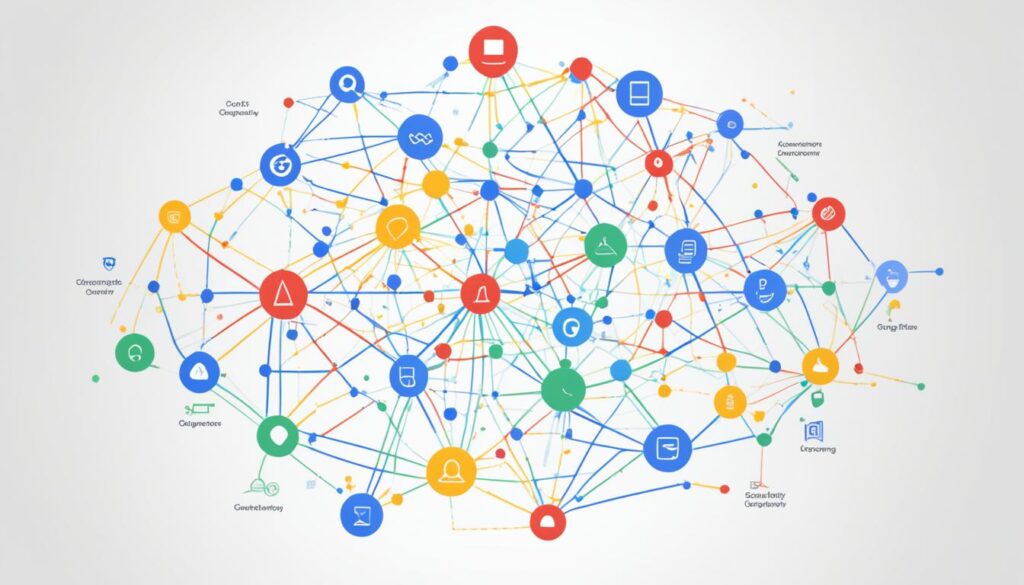Are you ready to uncover hidden information and optimize your search efficiency? Look no further than Google Dorking, a powerful technique that can unveil leaked passwords, sensitive data, and even provide access to files not meant for public consumption. However, mastering this technique can be challenging due to constantly evolving valid dorks and potential legal repercussions.
In this comprehensive guide, we will delve into the essential commands, operators, and search parameters of Google Dorking. By learning the ins and outs of this technique, you can unlock the secrets hidden in the vast ocean of information on the internet and enhance your search capabilities.
Get ready to become a Google Dorking expert with our expert tips and tricks!
Key Takeaways:
- Google Dorking is a powerful technique for uncovering hidden information.
- Mastering Google Dorking can optimize your search efficiency.
- Expert tips and tricks will help you navigate the ever-changing world of Google Dorking.
- Responsible usage is crucial to avoid legal and ethical issues.
- Unlocking the secrets of Google Dorking can provide valuable insights for personal, professional, and cybersecurity purposes.
What Is Google Dorking and How Does It Work?
Google dorking, also known as Google hacking, is an advanced search technique that allows users to uncover hidden information by performing specific searches using advanced operators. It involves combining various Google dorks to access files or data that may not be easily discoverable through regular search methods. This technique has a wide range of applications, including personal research, job hunting, cybersecurity, and penetration testing.
By leveraging Google dorking, individuals can dig deeper into the vast ocean of information available on the internet, uncovering valuable insights and uncovering hidden vulnerabilities. It’s a valuable tool for those looking to optimize their search efficiency and access targeted information for various purposes.
“Google dorking is like having a master key to unlock the door to hidden knowledge.”
Google Dorking in Action
Let’s consider an example to illustrate how Google dorking works. Suppose you’re interested in exploring online databases and want to search for files that contain sensitive information. By combining specific dorks such as “filetype:csv” (to search for CSV files) and “intext:password” (to search for files that contain the word “password”), you can narrow down your search and uncover files that may contain data with cybersecurity implications.

As shown in the image above, a targeted Google dork query can reveal a list of potentially vulnerable files containing sensitive information. Through such queries, Google dorking empowers individuals to access information that would otherwise remain hidden or require extensive manual search efforts.
With its advanced search capabilities and operators, Google dorking provides users with a powerful toolset for uncovering hidden data, exploring online resources, and gaining valuable insights.
Understanding Google Dorking Syntax and Operators
To effectively utilize the power of Google dorking, it is crucial to understand the syntax and operators used to construct search queries. These operators enable you to create targeted and effective search queries, allowing you to uncover hidden information with precision.
Here are some commonly used operators in Google dorking:
- site: This operator allows you to search for specific terms within a particular website. For example, using
site:wikipedia.org SEOwill retrieve search results containing the term “SEO” specifically from the website “wikipedia.org”. - filetype: With this operator, you can search for specific file types. For instance, using
filetype:pdf dorkingwill display search results that include PDF files related to “dorking”. - intext: The
intext:operator allows you to search for specific text within a website. For example, searching forintext:"SEO tips"will provide results that contain the exact phrase “SEO tips”. - inurl: This operator enables you to search for specific keywords within URLs. For example, using
inurl:blog SEOwill retrieve search results that include the term “SEO” within the URL of various blogs. - define: By using the
define:operator, you can find the definition of a word or phrase. For instance, searching fordefine:cybersecuritywill display the definition of the term “cybersecurity”.

By combining these operators with specific search terms, you can construct powerful and targeted search queries, enhancing your ability to uncover the information you seek. Whether you are conducting research, investigating vulnerabilities, or exploring the depths of the internet, mastering the syntax and operators of Google dorking will greatly optimize your search efficiency.
Advanced Techniques and Examples of Google Dorking
In addition to the basic syntax and operators, there are several advanced techniques that can be used to enhance the effectiveness of Google dorking. These techniques will enable you to uncover more specific types of information and identify potential vulnerabilities in web assets.
- Using Regular Expressions in Queries
- Using Dorking for Reconnaissance
- Chaining Operators to Make Specific Searches
- Finding Vulnerabilities in Web Applications or Servers
Regular expressions (regex) can be used to refine your search queries in Google dorking. By utilizing regex patterns, you can search for specific information that matches a particular format or structure. This technique is particularly useful when you’re looking for specific patterns in sensitive data, such as credit card numbers or social security numbers.
Google dorking can also be used for reconnaissance purposes, allowing you to gather information about a target. By using specific dorks, you can find websites, directories, or even individual files associated with your target. This information can provide valuable insights into their web presence, infrastructure, or potential vulnerabilities.
Chaining operators in Google dorking can help you make more specific searches and narrow down your results. By combining operators such as “site:”, “inurl:”, and “intext:”, you can create powerful queries that target specific keywords or phrases within a website or URL. This technique is particularly useful when you’re looking for specific information within a particular context.
One of the most powerful applications of Google dorking is finding vulnerabilities in web applications or servers. By using specific dorks, you can identify websites or servers that have misconfigured settings, outdated software versions, or other security weaknesses. This information can be invaluable for penetration testers or cybersecurity professionals looking to assess the security of their own assets or identify potential targets for further analysis.
These advanced techniques, when combined with the basic syntax and operators of Google dorking, will empower you to uncover specific information and vulnerabilities in web applications and servers. Remember to use these techniques responsibly and ethically, always obtaining proper authorization before accessing sensitive data or engaging in any form of hacking or unauthorized activities.
Important Considerations and Ethical Usage of Google Dorking
While Google Dorking can be a powerful tool for uncovering hidden information and optimizing search efficiency, it is crucial to understand the legal and ethical implications of its usage. Respecting the privacy of others and adhering to data privacy and hacking laws and regulations are essential in responsibly harnessing the capabilities of Google Dorking.
“With great power comes great responsibility.”
– Uncle Ben
Google Dorking should always be used ethically, ensuring that it is not employed for illegal activities or to harm others. Users should seek legal permission before accessing private data, and unauthorized intrusion into personal or sensitive information is strictly prohibited.
Legal Implications
Using Google Dorking inappropriately can have severe legal consequences. Unauthorized access to confidential data, infringing intellectual property rights, or violating privacy laws can result in legal actions, fines, or even imprisonment. Always ensure that your use of Google Dorking complies with the laws and regulations of your jurisdiction.
Ethical Guidelines
Respecting ethical guidelines is crucial when utilizing Google Dorking. Here are some essential considerations to keep in mind:
- Obtain proper authorization and seek legal permission before accessing private or sensitive information.
- Use Google Dorking for legitimate purposes such as personal research, cybersecurity, or job applications.
- Respect the privacy of individuals and organizations, refraining from exploiting vulnerabilities or accessing unauthorized resources.
- Avoid using Google Dorking to gather information that could be used for malicious intent, harassment, or stalking.
- Stay up-to-date with evolving laws and regulations related to data privacy, hacking, and intellectual property rights.
By adhering to these ethical guidelines, you can harness the power of Google Dorking responsibly and ensure that your actions contribute positively to the digital ecosystem.
Conclusion
In conclusion, Google Dorking is a powerful technique that allows users to unlock secrets and optimize search efficiency. By mastering the syntax, operators, and advanced techniques of Google Dorking, individuals can uncover hidden information, find vulnerabilities, and gather valuable insights for personal, professional, and cybersecurity purposes.
However, it is crucial to emphasize the responsible usage of Google Dorking. Users must respect privacy and adhere to legal and ethical guidelines. Seeking proper authorization and avoiding illegal activities are essential to maintain a responsible approach to Google Dorking.
With the help of expert tips and tricks, individuals can harness the full potential of Google Dorking and explore the vast realm of information available on the internet. By using this technique responsibly, users can unlock the secrets hidden within the digital landscape and optimize their search efficiency.
FAQ
What is Google dorking?
Google dorking, also known as Google hacking, is an advanced search technique that involves performing specific searches using advanced operators to find specific types of files or information.
How can Google dorking be used?
Google dorking can be used for personal research, job applications, cybersecurity, and penetration testing. It is a valuable tool for anyone looking to dig deeper into the vast amount of information available on the internet.
What operators are commonly used in Google dorking?
Some common operators used in Google dorking include “site:”, “filetype:”, “intext:”, “inurl:”, and “define:”. These operators allow users to search for specific terms, file types, text within websites, keywords in URLs, and the definition of a word or phrase.
Are there any advanced techniques for effective Google dorking?
Yes, there are several advanced techniques that can enhance the effectiveness of Google dorking. These techniques include using regular expressions in queries, using dorking for reconnaissance, chaining operators, and finding vulnerabilities in web applications or servers.
What are the legal and ethical considerations when using Google dorking?
It is important to use Google dorking legally and ethically, respecting the privacy of others and following the laws and regulations related to data privacy and hacking. Users should always seek legal permission before accessing private data and avoid using Google dorking for illegal activities or to harm others.








